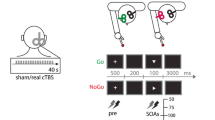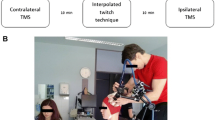Abstract
Highly selective activation of the desired muscles for each movement and inhibition of adjacent muscles is attributed to surround inhibition (SI) which differentially modulates corticospinal excitability in active and surrounding muscles. Cerebellar brain inhibition (CBI) is another inhibitory neuronal network which is known to be active at rest and during tonic muscle contraction. The way in which CBI may be modulated at movement onset and its relationship with SI has not previously been investigated. We assessed motor evoked potential (MEP) size and CBI in first dorsal interosseus (FDI) and abductor digiti minimi (ADM) muscles at rest and during a simple motor task where FDI was an active muscle and ADM was not involved in the movement (surround muscle). At onset of movement, MEP size in ADM was significantly suppressed, confirming the existence of SI. In contrast, CBI in both muscles was found to be significantly decreased at the onset of the movement. This was confirmed even after adjustments for changes in MEP size occurring due to onset of muscle activity in FDI and the effects of SI in ADM. Our findings fail to functionally link SI with CBI, but they do indicate a non-topographically specific modulation of CBI in association with initiation of voluntary movement.




Similar content being viewed by others
References
Battaglia F, Quartarone A, Ghilardi MF, Dattola R, Bagnato S, Rizzo V, Morgante L, Girlanda P (2006) Unilateral cerebellar stroke disrupts movement preparation and motor imagery. Clin Neurophysiol 117(5):1009–1016
Beck S, Hallett M (2010) Surround inhibition is modulated by task difficulty. Clin Neurophysiol 121(1):98–103
Beck S, Schubert M, Richardson SP, Hallett M (2009) Surround inhibition depends on the force exerted and is abnormal in focal hand dystonia. J Appl Physiol 107(5):1513–1518
Brighina F, Palermo A, Panetta ML, Daniele O, Aloisio A, Cosentino G, Fierro B (2009) Reduced cerebellar inhibition in migraine with aura: a TMS study. Cerebellum 8(3):260–266
Daskalakis ZJ, Paradiso GO, Christensen BK, Fitzgerald PB, Gunraj C, Chen R (2004) Exploring the connectivity between the cerebellum and motor cortex in humans. J Physiol 557(Pt 2):689–700
Di Lazzaro V, Oliviero A, Pilato F, Saturno E, Dileone M, Mazzone P, Insola A, Tonali PA, Rothwell JC (2004) The physiological basis of transcranial motor cortex stimulation in conscious humans. Clin Neurophysiol 115(2):255–266
Fisher KM, Lai HM, Baker MR, Baker SN (2009) Corticospinal activation confounds cerebellar effects of posterior fossa stimuli. Clin Neurophysiol 120(12):2109–2113
Grill SE, Hallett M, McShane LM (1997) Timing of onset of afferent responses and of use of kinesthetic information for control of movement in normal and cerebellar-impaired subjects. Exp Brain Res 113(1):33–47
Horwitz B, Deiber MP, Ibanez V, Sadato N, Hallett M (2000) Correlations between reaction time and cerebral blood flow during motor preparation. Neuroimage 12(4):434–441
Houk JC, Wise SP (1995) Distributed modular architectures linking basal ganglia, cerebellum, and cerebral cortex: their role in planning and controlling action. Cereb Cortex 5(2):95–110
Kaneko K, Kawai S, Fuchigami Y, Morita H, Ofuji A (1996) The effect of current direction induced by transcranial magnetic stimulation on the corticospinal excitability in human brain. Electroencephalogr Clin Neurophysiol 101(6):478–482
Pinto AD, Chen R (2001) Suppression of the motor cortex by magnetic stimulation of the cerebellum. Exp Brain Res 140(4):505–510
Saito Y, Yokota T, Yuasa T (1995) Suppression of motor cortical excitability by magnetic stimulation of the cerebellum. Brain Res 694(1–2):200–206
Shin HW, Sohn YH, Hallett M (2009) Hemispheric asymmetry of surround inhibition in the human motor system. Clin Neurophysiol 120(4):816–819
Sohn YH, Hallett M (2004a) Disturbed surround inhibition in focal hand dystonia. Ann Neurol 56(4):595–599
Sohn YH, Hallett M (2004b) Surround inhibition in human motor system. Exp Brain Res 158(4):397–404
Ugawa Y, Uesaka Y, Terao Y, Hanajima R, Kanazawa I (1994) Magnetic stimulation of corticospinal pathways at the foramen magnum level in humans. Ann Neurol 36(4):618–624
Ugawa Y, Uesaka Y, Terao Y, Hanajima R, Kanazawa I (1995) Magnetic stimulation over the cerebellum in humans. Ann Neurol 37(6):703–713
Werhahn KJ, Taylor J, Ridding M, Meyer BU, Rothwell JC (1996) Effect of transcranial magnetic stimulation over the cerebellum on the excitability of human motor cortex. Electroencephalogr Clin Neurophysiol 101(1):58–66
Acknowledgments
MJE is supported by an NIHR Clinician Scientist Grant. TAS is supported by an NIHR Clinical Research Fellowship. BvdW and BSH are supported by a grant from the Prinses Beatrix Fonds.
Author information
Authors and Affiliations
Corresponding author
Rights and permissions
About this article
Cite this article
Kassavetis, P., Hoffland, B.S., Saifee, T.A. et al. Cerebellar brain inhibition is decreased in active and surround muscles at the onset of voluntary movement. Exp Brain Res 209, 437–442 (2011). https://doi.org/10.1007/s00221-011-2575-5
Received:
Accepted:
Published:
Issue Date:
DOI: https://doi.org/10.1007/s00221-011-2575-5




